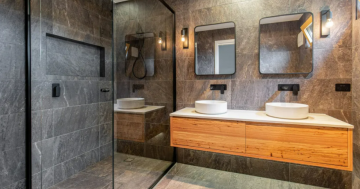
In renovation, as in anything, you get what you pay for. Photo: Sergey Spritnyuk.
“I was called to check out a leaking bathroom. I found it was not waterproofed and the entry tiles had carpet underlay under them,” he says.
“Not only was this client stuck with the extra costs, but their family had been without a bathroom for 12 months due to project delays.”
It was among the most memorable non-compliant rectification works the director of Mark Sheppard Bathrooms and Renovations had ever seen, but it was far from the first or only.
In his more than 25 years of experience, a good percentage of Mark’s business has been fixing the results of shoddy work, and he says the overall quality of renovations has “fallen dramatically over the last 15 years”.
“We are frequently fixing bathrooms and other spaces that are quite new. A bathroom or kitchen should last 20-plus years, not three to five,” he says.
Mark says there’s no shortage of excellent tradies doing fantastic work in Canberra, but choosing the right renovator is becoming increasingly difficult as some in the industry cut corners to meet market demand for cheap work.
Inexperienced workers, inferior materials and omissions of key aspects of the works that must later be added as variations are among the unintended consequences.
“Currently, consumers collect multiple quotes, and it’s not uncommon to see variations of tens or even hundreds of thousands of dollars, so it might seem like a no-brainer in terms of price. However, this creates pressure on the industry to price cheaply to be even considered for projects,” Mark says.
“In reality, the difference between the prices is simply represented elsewhere – in the quality of the tradespeople doing the work, the comprehensiveness of the services you get, the quality of materials in the build and even whether or not building standards are being followed.
“In this way, lower quality materials and workmanship are rewarded, but ironically, consumers are ending up paying more for their renovation than intended and often end up paying the average renovation cost anyway, with lower quality work.”

A before and after of a kitchen renovation following a fire that resulted from shoddy workmanship. Photo: Mark Sheppard.
A key challenge for consumers is the lack of independent guidance on average building and renovation costs, leaving a lot of guesswork.
Multiple variables, such as the construction of your home (a brick veneer house with timber flooring is cheaper to renovate than full brick walls with concrete grounds), the scale and scope of the renovations, the quality of materials, including appliances and fixtures, and whether or not your home contains silica or asbestos all impact costs.
Mark points out that industry resources show an average of $50,000 to $60,000 for completed bathrooms, $50,000 to $70,000 plus appliances for the average completed kitchen, and $25,000 to $35,000 for a laundry with cabinetry.
“It’s not uncommon for someone to receive quotes for substantially less. If you do, it’s time to take a step back and ask, ‘Why? How?'” he says.
“The other week, I had a client who asked me why my quote for her work was $10,000 more than that of a competitor, and as it turned out, mine included $10,000 worth of plumbing, which was not included in the other quote.
“The Australian Construction Association states builders work on really low margins – often about 6 per cent – and it’s a big concern for the industry. So if you have a quote that’s thousands cheaper, that cost is most certainly reflected elsewhere.”
When things go very wrong, there’s limited recourse for consumers, as the ACT Civil and Administrative Tribunal (ACAT) can only hear civil claims up to $25,000 – about half the cost of a new bathroom or kitchen.
This came to mind as Mark completed recent work at a home following extensive fire damage.
“The kitchen had a fire start in the ceiling above the flue. The range hood was meant to be flued out and had not been, resulting in an accumulation of oils and fats in the ceiling,” Mark says.
“We identified several electrical issues during the restoration. A simple flue kit installation and electrical check could have avoided a near tragedy.
“Like anything, you get what you pay for. You may think that in accepting the cheaper quote, you’re ‘beating the system’, but the reality is you’re shorting yourself in the long term and may end up tens of thousands in the red and with little recourse. The industry average is not the average of the quotes you receive, it is the average of the end of contract cost for that type of renovation.
“When you’re assessing your home renovation quotes, try to think of it not just as a cost but as an investment in your single greatest asset.”
For more information or a (fair and comprehensive) quote, visit Mark Sheppard Bathrooms & Renovations.




















